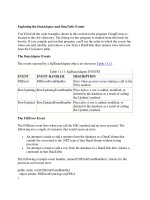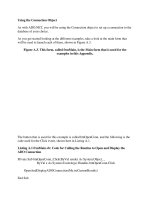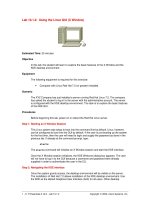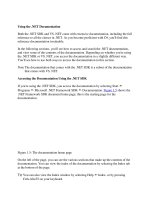Tài liệu Using the LOCAL_PREF and MED Attributes pdf
Bạn đang xem bản rút gọn của tài liệu. Xem và tải ngay bản đầy đủ của tài liệu tại đây (25.8 KB, 3 trang )
1 - 3 Semester 5: Advanced Routing v2.0 - Lab 8.8.4 Copyright 2001, Cisco Systems, Inc.
8.8.4 Using the LOCAL_PREF and MED Attributes
Fa0/0 200.100.50.1/24
S0/1 172.24.1.17/30S0/0 192.168.1.6/30
S0/0 172.24.1.18/30S0/0 192.168.1.5/30
AS 200 AS 400
AS 300
SanJose3
ISP1A
ISP1B
S0/1 10.1.1.1/30
S0/1 10.1.1.2/30
Undesired Link Desired Link
Objective
In this lab, you use the LOCAL_PREF and MED attributes to modify BGP’s behavior and
implement routing policy.
Scenario
You are asked by International Travel Agency’s Internet service provider to configure
BGP routing policies for its autonomous systems. This high-tier provider makes use of
two different AS numbers. They asked you to configure BGP so that traffic always uses a
designated path to reach networks in International Travel Agency’s AS 100.
First, they would like you to configure the LOCAL_PREF attributes on routers ISP1A and
ISP1B so that they always use this path to reach AS 100. Second, the ISP wants you to
use the MED attribute to influence SanJose3’s BGP routing decisions. By configuring the
MED, you must force SanJose3 to always use the desired path to reach the 10.0.0.0
network.
Step 1
Build and configure the network according to the diagram, but do not configure a routing
protocol.
Use ping to test connectivity between the directly connected routers.
2 - 3 Semester 5: Advanced Routing v2.0 - Lab 8.8.4 Copyright 2001, Cisco Systems, Inc.
Step 2
Configure BGP for normal operation. Enter the appropriate BGP commands so that
SanJose3 advertises its Ethernet network and the other routers advertise the 10.0.0.0
network:
ISP1A(config)#router bgp 200
ISP1A(config-router)#neighbor 192.168.1.6 remote-as 300
ISP1A(config-router)#neighbor 10.1.1.2 remote-as 400
ISP1A(config-router)#network 10.0.0.0
SanJose3(config)#router bgp 100
SanJose3(config-router)#neighbor 192.168.1.5 remote-as 200
SanJose3(config-router)#neighbor 172.24.1.18 remote-as 400
SanJose3(config-router)#network 200.100.50.0
ISP1B(config)#router bgp 400
ISP1B(config-router)#neighbor 172.24.1.17 remote-as 100
ISP1B(config-router)#neighbor 10.1.1.1 remote-as 200
ISP1B(config-router)#network 10.0.0.0
Verify that these routers have established the appropriate neighbor relationships by
issuing the show ip bgp neighbor command at each router.
Step 3
Check ISP1A’s routing table. According to ISP1A’s routing table, SanJose3 (192.168.1.6)
should be used to reach 200.100.50.0 /24.
Check ISP1A’s BGP table. Note that ISP1A has learned about two paths to 200.100.50.0
/24.
1. Which path is better?
At ISP1A’s console, issue the command show ip bgp 200.100.50.0.
2. Based on the output of this command, what is the local preference value of paths 1 and
2?
Your task is to configure ISP1A to apply a local preference value so that the router will
use the other path to 200.100.50.0 (via ISP1B).
Start by configuring a route map on ISP1A that will set the local preference value to 150,
which is higher (and thus, better) than 100:
ISP1A(config)#route-map viaAS400
ISP1A(config-route-map)#set local-preference 150
ISP1A(config)#router bgp 200
ISP1A(config-router)#neighbor 10.1.1.2 route-map viaAS400 in
After you complete this configuration, issue the clear ip bgp * command on ISP1A.
Wait several seconds, and then use the show ip bgp command to view ISP1A’s BGP
table. Both paths should again be present in the table, but the best path should now be
the route via ISP1B (10.1.1.2).
3. According to the output of this command, what is the local preference value of the route
to 200.100.50.0 via 10.1.1.2?
3 - 3 Semester 5: Advanced Routing v2.0 - Lab 8.8.4 Copyright 2001, Cisco Systems, Inc.
Note that no local preference value is displayed for the route via 192.168.1.6, because
this route has a default local preference value of 100, and default values are not listed in
the BGP table.
Check ISP1A’s routing table.
4. Is the route to 200.100.50.0/24 via 10.1.1.2 installed?
Step 4
Finally, you configure ISP1A and ISP1B so that they send different metrics to SanJose3
about the network 10.0.0.0. This method allows you to influence the path selection of a
router that is not necessarily under your administrative control.
SanJose3 should have two paths to the 10.0.0.0 network. As currently configured,
SanJose3 will install the first path it learns about in the routing table as the best path. You
will alter the MED values sent to SanJose3 in order to force the router to always choose
the path via ISP1B.
First, configure ISP1A to advertise a relatively high metric in updates to SanJose3:
ISP1A(config)#route-map badmetric
ISP1A(config-route-map)#set metric 150
ISP1A(config-route-map)#router bgp 200
ISP1A(config-router)#neighbor 192.168.1.6 route-map badmetric out
Next, configure ISP1B to advertise a relatively low metric in updates to SanJose3:
ISP1B(config)#route-map goodmetric
ISP1B(config-route-map)#set metric 50
ISP1B(config-route-map)#router bgp 400
ISP1B(config-router)#neighbor 172.24.1.17 route-map goodmetric out
After you configure these two routers to advertise different metrics to SanJose3, you
must also configure SanJose3 so that it compares metrics from different autonomous
systems:
SanJose3(config)#router bgp 100
SanJose3(config-router)#bgp always-compare-med
Issue the clear ip bgp * command on SanJose3, wait several seconds, and then
check SanJose3’s BGP table with the command show ip bgp. SanJose3 should have
two paths to the 10.0.0.0 network, but each path will have a different metric.
Check SanJose3’s BGP table. The best next hop to 10.0.0.0/8 should be 172.24.1.18.
1. What is the metric value of this route to 10.0.0.0/8?
2. What is the default metric value of BGP routes?









